Disclosure: GeekDad received a review copy of this title. Making purchases through the affiliate links helps to support us financially. Thanks!
Carcassonne is one of the titles that pulled me into tabletop gaming about a decade ago. Sure, I’d always liked games as a kid and I played various board and card games, but it was Carcassonne that really hooked me. It’s the game that led me to BoardGameGeek, a huge rabbit-hole that I’m still exploring now.
While it’s not one that hits the table often these days, I’ve always got a virtual game or two of Carcassonne on my iPhone—the app is still, in my opinion, the gold standard for board game apps, and well worth the price.
There’s a new version of the base game out now—although the box just says “Carcassonne,” there are a few differences: most apparent is the new artwork for the tiles, though the gameplay is largely the same. The main difference in gameplay is the Abbot mini-expansion, which is only available as part of this base set, so if you already own Carcassonne you’ll have to decide if it’s worth replacing your old set.
At a glance: Carcassonne is a tile-laying game for 2 to 5 players, ages 7 and up, and takes about 35 minutes to play. It retails for $34.99. The age rating is pretty good—I know some kids start playing at 6 or 7, but it’s also great for adults.
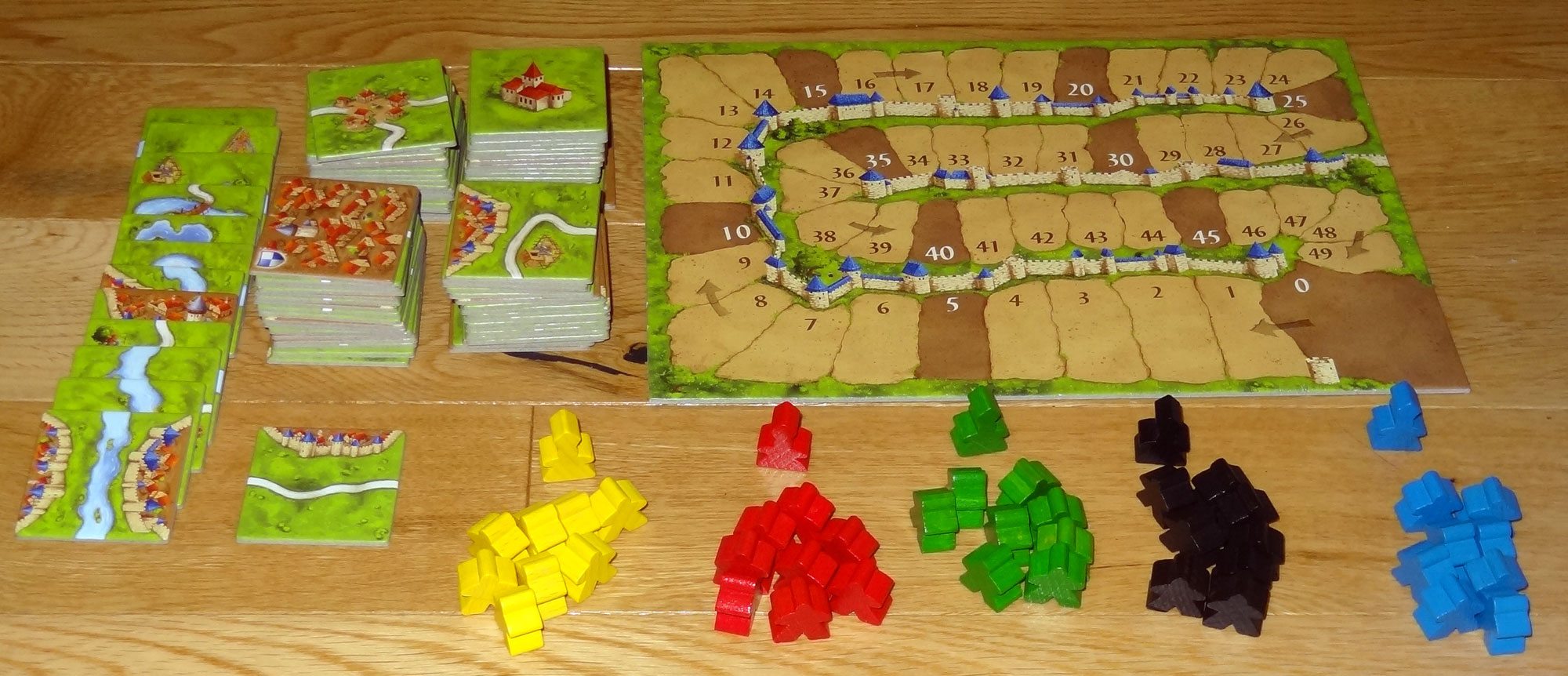
Components:
- 72 Land tiles
- 12 River tiles
- 1 scoreboard
- 40 meeples (8 each in five colors)
- 5 Abbot meeples (in 5 colors)
OK, so the “meeples” I’m referring to are technically called “followers,” and you won’t find the word “meeple” anywhere in the rules. Still, these little wooden people have long been called meeples by the boardgaming community, so I’m sticking to that term.
The Abbot looks kind of like a chess bishop, with robes and a tall hat.
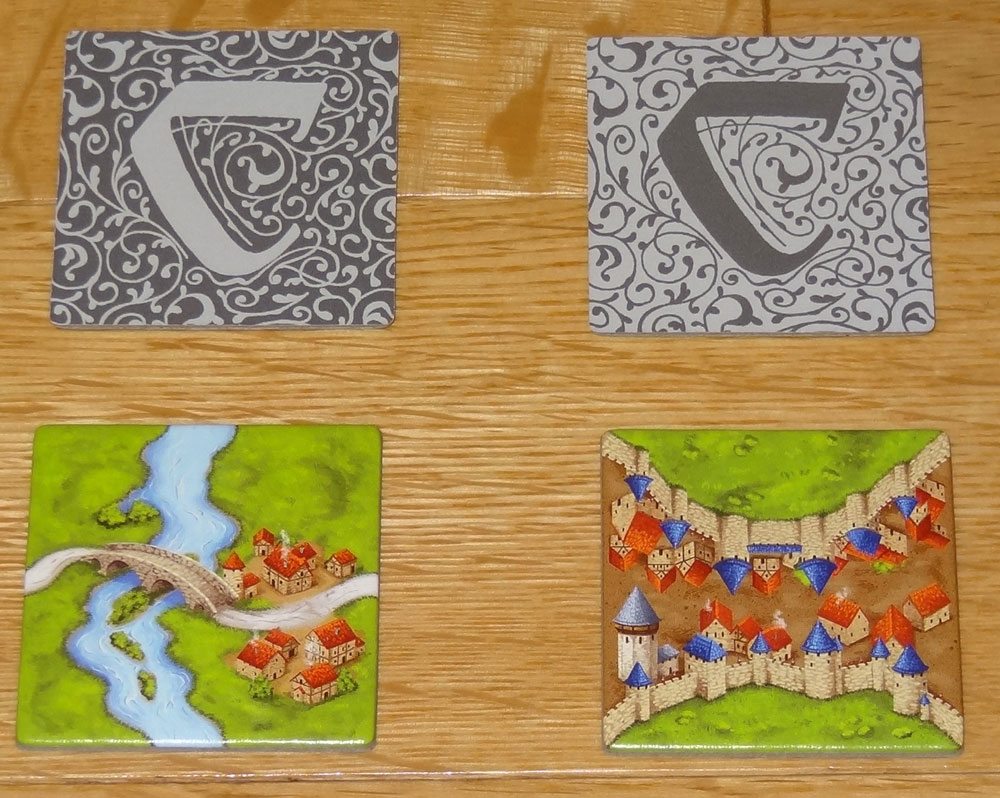
The tiles are 1.75″ square, and punch out really cleanly. The backs still use the same design as before so the set is compatible with any existing Carcassonne sets you may already have. The artwork on the front of the tiles, however, has been redone. It still looks similar, but the walls now have blue-roofed towers instead of red, and some of the tiles have colorful flower gardens in the fields. Aside from that, there are subtle differences in the artwork but it still matches the original sets pretty well.
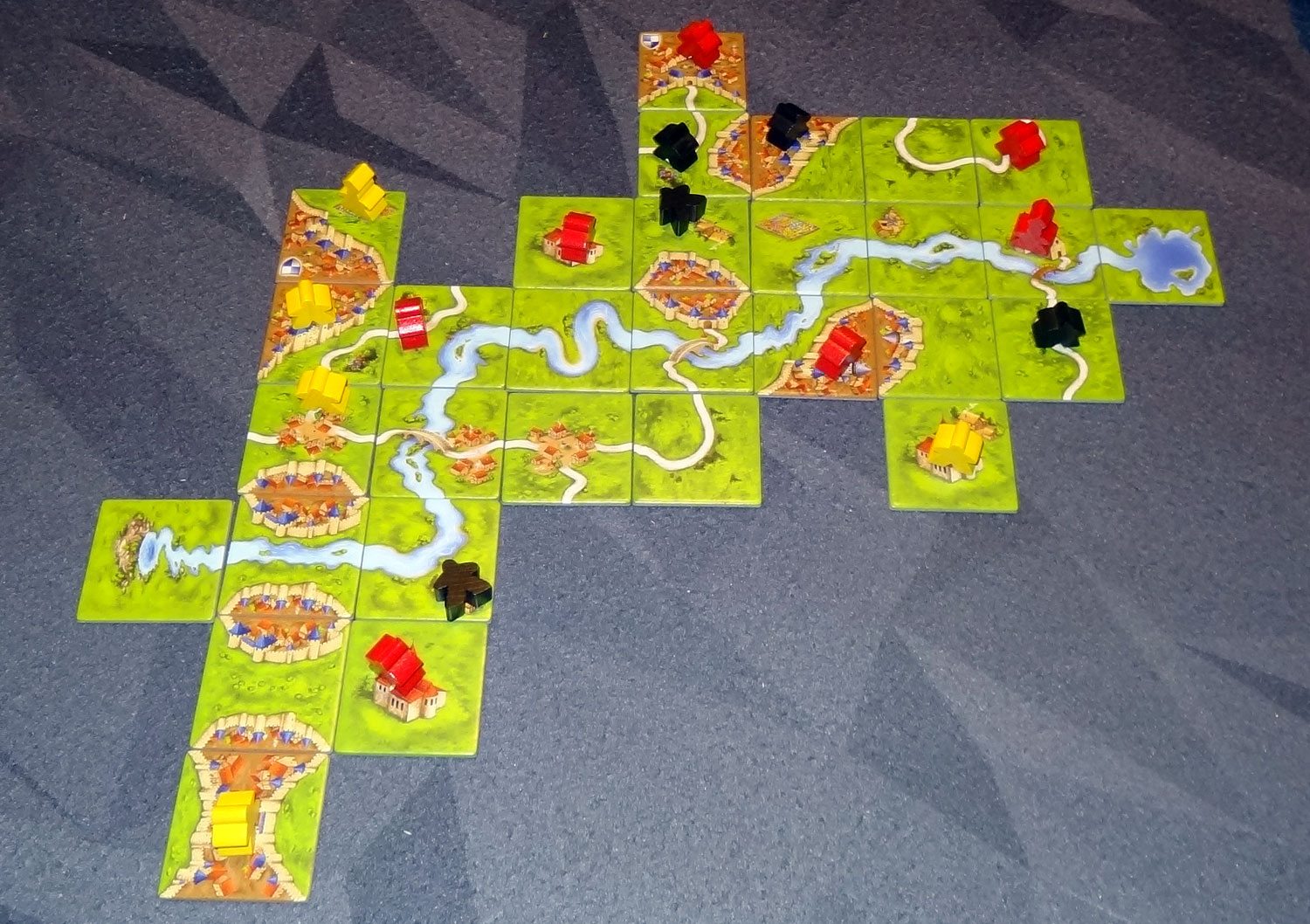
How to play
You can download a copy of the rulebook as a PDF here. Since Carcassonne isn’t a new game, I’ll give a very brief overview here without getting into too many details.
The goal is to score the most points by the end of the games, when the tiles run out.
Each player takes all of their meeples and puts one on the scoreboard. The starting tile is set in the center of the table (or the river source if you’re using the included River expansion).
On your turn, you draw a tile and place it anywhere so that it matches any edges that it’s touching. Then you may place one of your meeples on that tile—meeples may be placed on roads, in cities or monasteries (formerly known as cloisters), or in the fields, but only if nobody already occupies that feature. Then, if any features are completed, those features score points and the meeples on those features are returned to their owners.
Farmers (meeples placed in the fields) only score at the very end of the game, and award points based on the number of completed cities their fields touch. Other features get partial scoring if they’re incomplete at the end of the game.

The new feature included in this base set is the Abbot. Each player has one Abbot meeple. Some of the tiles now have little flower gardens in the fields. An Abbot may be placed either in a monastery or in a flower garden when you play that tile (instead of placing a meeple as usual). Flower gardens score the same way as monasteries—when it is surrounded by 8 tiles, you score 9 points and remove the Abbot.
However, there’s an additional ability: on a subsequent turn, if you do not play a meeple on your turn, you may optionally take back your Abbot and get partial scoring on the monastery or flower garden immediately.
One other note: In the older rules, I believe that farms did not extend around the source of the River, but I didn’t spot that rule here. It’s a minor rule change, removing a rule that was often forgotten, but veteran players should note that it makes getting a farm at the source of the river a little more advantageous.
And now, a musical interlude:
The Verdict
If you have never played Carcassonne, I highly recommend it. It’s one of my favorite games—and that’s saying something, because I have a really hard time picking favorites of anything. It’s simple enough to teach a kid, and there’s an elegance to the fact that there are so few rules (at least in the base game). But don’t be fooled: there’s still a lot of strategic depth to the game. It can be a casual, light-hearted map-building game, or it can be downright cutthroat as you battle over who gets the farm.
I first encountered Carcassonne nearly a decade ago, and I still love playing it now. This new edition could make a great game for that friend of yours who’s just getting into board gaming now and doesn’t yet have all the essentials. One of my favorite things about Carcassonne is looking at the map at the end of the game and seeing all the crazy-shaped cities, roads to nowhere, clusters of cloisters, and so on.
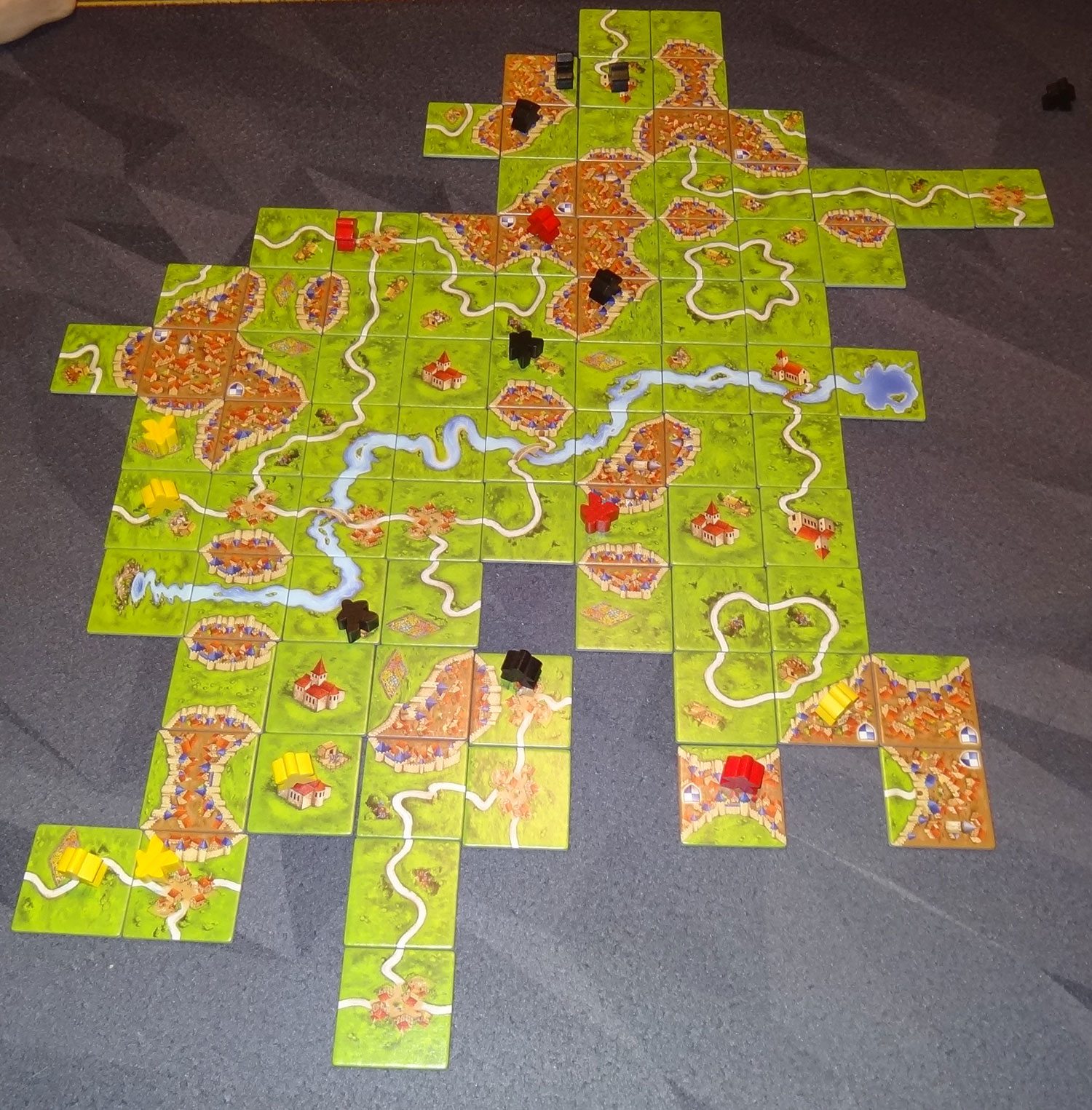
If you already own Carcassonne, I’m not sure that you really need to rush out and buy this one. The Abbot is a fun twist, but I’m not sure that it’s enough of a game-changer that it’s worth buying a whole new set. I know that publisher Hans im Gluck (Z-Man is the US distributor) has taken some heat from existing fans for continuing to release new base sets with features that can’t be purchased separately. Since there are only 8 tiles with flower gardens on them, the Abbot could easily be packaged as one of the Carcassonne mini expansions. I suppose time will tell if it gets repackaged later on.
The Carcassonne New Edition is available now; look for it at your local game store, or buy it from Amazon or directly from Z-Man Games.
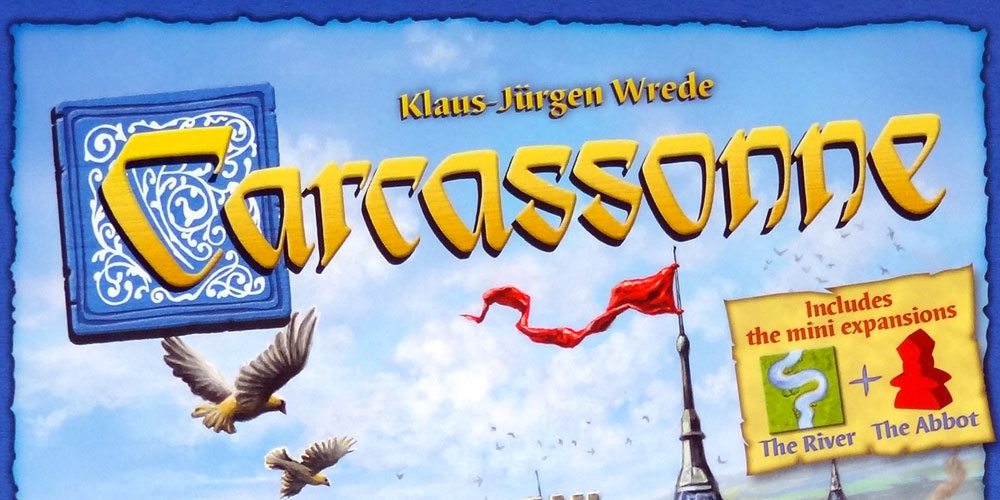




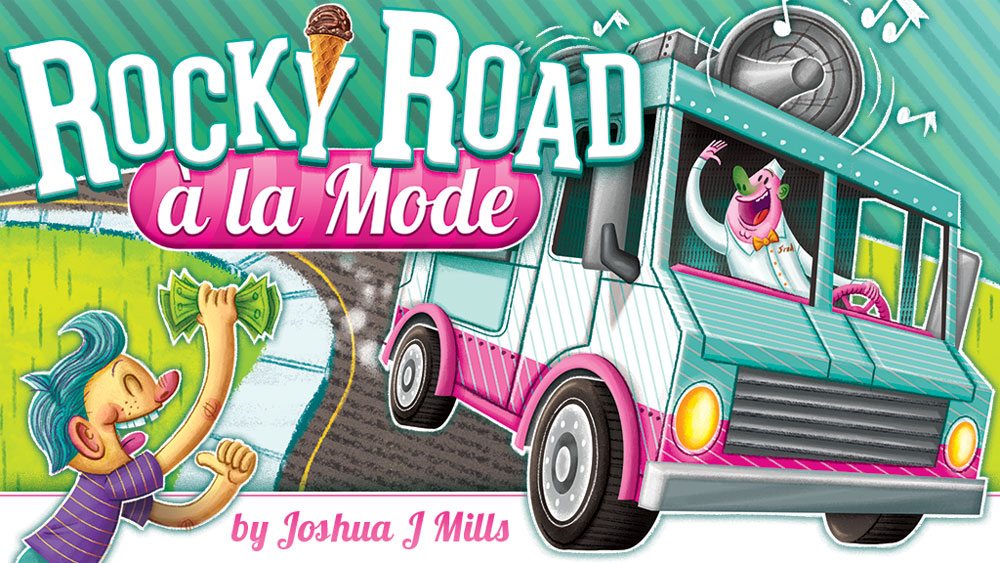
I haven’t played, but Carcassonne was recommended by a friend. I see the version you reviewed here is ~$44 on Amazon and has 2 expansions (The River & The Abbott), but for ~$55-$60 I could get the Carcassonne Big Box, which comes with 5 expansions (Inn & Cathedrals, Traders & Builders, The River, Hills & Sheep, and The Wheel of Fortune). What would you recommend for a first time player/buyer?
Hi, Scott, for some reason the version I have linked on Amazon is higher than retail, but includes those shiny gold drawstring bags. I’m guessing that you’ll see other versions available soon but since it was just recently released that’s the only version I found so far. Ordering directly from Z-Man (or maybe at your local game store) would potentially be cheaper.
The Big Box is actually a good deal if you don’t already own any of them—assuming you like the game. I would say if you get the chance, try it out and see if you enjoy playing it enough to spend $60 on it. The expansions add a lot more tiles, but also introduce new rules—but you can get a lot of play out of the base set without ever using the expansions, if you want.
Most base sets will include some version of The River. I like Inns & Cathedrals a lot, and have played with Traders & Builders a little, but haven’t played Hills & Sheep or The Wheel of Fortune, so I can’t really comment on those in particular.
Download the game app on a phone or tablet ($5 investment) , play a game or two and see if you basically enjoy the game flow. If yes I would suggest the Big Box set (box is stink’in huge beyond need) as it lets you modify the basic game play to keep it fresh. And if you decide to keep it check out Esty there is a wooden box sold there that holds the big box version in half the space of the actual box and looks really nice.
Carcassonne is one of my favorite board games. Great replay-ability, in that no two games are ever the same! The new artwork is great, but as an owner of the Big Box, I can’t justify the purchase. For a new player though, I can’t recommend the game enough. Buy it now!
Great review, but the original rules for the river DO have the field wrapping around the spring. Having that divide the farm is a popular house rule.
Interesting—I learned on an old set and from what I understand some of the Carcassonne rules have been tweaked over the years. In particular, I remember learning that two-tile cities were only worth 2 points rather than 4 (2 per tile) but that rule was changed fairly early on. I’ve also seen discrepancies about farms (3 points per city vs. 4 points per city), and I do remember learning that the spring separated farms, which bothered me because it really looked like it was connected. However, it wasn’t my copy of the game so I can’t go look it up now; maybe it was indeed a house rule that I was taught incorrectly.
I found my source, at least. I had used this document on BGG as a rules compilation: https://boardgamegeek.com/filepage/9199/carcassonne-rules-compilationdoc and it specifically states that “the farm wraps around the lake, but not around the spring.” I’d assumed that was based on official rules, but apparently not.
Late follow-up, but they actually made a mini-expansion in an issue of games quarterly magazine that included a spring with a road coming out of the top.
https://boardgamegeek.com/image/162877/carcassonne-mini-expansion?size=original
The reason the price has changed is Christmas demand mixed with slow restocking.
I’d personally by the Big Box. My brother in law got #5 a few years ago and each expansion can really change how the game feels. I thought the game was fun, but not fun enough to purchase my own, when we played with most of his expansions. Then we tried Base + Princess and Dragon and it immediately became a MUST HAVE game in my house that I now have to wait until the stores restock it.
Even if you dont’ like it, once a Big Box goes out of print you can sell it for well over your $60 investment. You can’t do that with the ‘overpriced because of scarcity’ base game right now.
Thank you Jonathan!
We will export one new german edition next week as a gift to out french exchange daughter. We´ve got a french rule for the basic game last year, but i can´t find an french one for abbots and gardens. To help understanding the new extension, she will get the original from the package and your english one.
Keep on playing
Thorsten from Germany
Hello
I am trying to understand the rules for The Abbot mini expansion. I understand that you can place either an Abbot or a meeple on a monastery, but can you put a meeple on a flower garden? The instructions say that you can place on a garden, either an abbot or a meeple, and after some sentences, it says that only an abbot may be placed on a garden… I don’t get it… what can you put on a flower garden? THank you!
Hi, my understanding is that only the abbot may be placed on a flower garden. For monasteries, it’s an abbot OR a regular meeple. I think the reason it says you may place a meeple or an abbot is because you can still place a regular meeple on the tile in its usual spots—but not on the flower garden.
I think you are right! The meeple is placed as usual (according to the basic rules) and the abbot may be placed ONLY on a monastery or an a flower garden. The abbot can be removed whenever you want (if you don’t place a meeple when it’s your turn). A meeple can’t be placed on a flower garden but you can still place it on a monastery (according to the basic rules) when you use the abbot mini-extension. Am I right?
I hope that this will clarify the rules for other readers because the rulebook isn’t so clear about the abbot gameplay…
Yes, that sounds exactly right. Regular meeples continue to play exactly as before, and flower gardens do nothing for them. The Abbot may only be placed on monastery or flower garden (which scores like a monastery) but its special power is that you may remove it early and score partial points if you don’t place a meeple on that turn.
hi, is this compatible with first and second expansions ? with new graphic i don’t know if it is possible. thanks
Hi—the backs of the tiles are the same so that if you mix them in with older sets it will still be compatible. However, there are differences in the artwork so it will not all match the look of the older sets.
do you think that will be a new retheme for the expansion ?
I’m not sure of that—I would assume that future expansions will probably use the new theme, but I don’t know that they’re planning to retheme all the existing expansions.
Hello everyone! I was thinking of buying a game of Carcassonne. But then, I stumbled upon a problem. I do not want to spend all my pocket money (i am a student) on a big box, even thought i ran across it. I was thinking of getting either Old Carcassonne with The princess and the dragon expansion. The deal from my local game shop was 19 dollars for both(with 50% off cause my often friday night magic visits xD). They also have the new edition for 16 dollars. I know that the first deal was better, but I AWFULLY love the river… And for the big box, a game shop in a different town close to mine has it but it is kinda a ripoff… They sell no.5 at 120 dollars, which is unacceptable. And Amazon is out of comparison because i live in EU, and Amazon from Germany has only copys on German. And Amazon from America wont send to Europe…
Help pls…